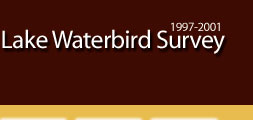 |
 |
 |
||||||||||||
 |
 |
 |
 |
 |
 |
 |
 |
|||||||
|
Preface • Introduction • Study Objectives • Community Participation • Regional, Physical and Ecological Setting Methods • Survey Protocol • Surveyors • Data Compilation • Data Analysis Results • Migration Chronology • Breeding Species • GSL Species Accounts • Species Distribution Discussion • Recommendations • Acknowledgements • Definitions/Abbreviations • Literature Cited Report & Appendices: 1 • 2 • 3 • 4 • 5 • 6 • 7 • 8 21-Year Waterbird Survey Synopsis & Appendices: 1B • 2B • 4B • 5B • 6B • 8B
|
Data CompilationWeather information was collected by surveyors and from local climatological data reports from the National Oceanic and Atmospheric Administration. Lake elevation data measured by a gauge at Boat Harbor, South Arm was provided by Wallace Gwynn, Utah Geological Survey. The project coordinators designed a data form suitable for all survey types. Participants recorded weather information and bird counts by species. Additionally, habitat evaluations, and species use and behavior data were recorded in survey sites that included point samples. Project coordinators encouraged team leaders to send in data forms at the end of every month. Data were then entered into a Paradox software database. Yearly Paradox data sets were sent to Jonathan Bart, United States Geological Survey (USGS), to be organized and transformed into Excel software tables that were more easily used by project data managers. The modified tables filled in missing data points by calculating an average of existing values on either side of a missed survey. Also, survey areas that were extremely incomplete were not included in lake-wide calculations (Appendix 2). Annual summary reports were written and distributed to all participants. |